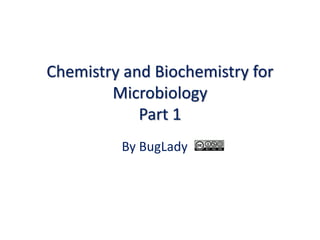
Chemistry Review for Microbiology Students
- 1. Chemistry and Biochemistry for Microbiology Part 1 By BugLady
- 2. Structure and Function Atoms and molecules Chemical bonds strength Water: the molecule of life Carbohydrates: (energy source, storage, and cell structure) Lipids (energy storage and membrane main component) Proteins (enzymes, transporters, movement) Nucleic acids (genetic material, small effector molecules)
- 4. Biologically Important Elements Present in large amounts C= every organic molecule, CO2 H= water, H+ , all organic molecules O=water, e- acceptor, all organic molecules N= proteins, nucleic acids, some vitamins P= phospholipids, inorganic P, nucleic acids S= proteins, some vitamins Jul-14 4
- 5. Why isn’t calcium mentioned as a most abundant element in this class? Jul-14 5
- 6. Biologically Important Elements Elements required in smaller amounts Electrolyte balance, protein stabilization, shells of some microorganisms o Cations: K+ (potassium), Na+ (sodium), Fe2+/3+ (iron), Ca2+ (calcium), Mg2+ (magnesium) o Anions: Cl- (chlorine), PO4 -3 (inorganic phosphate) Jul-14 6
- 7. Biologically Important Elements Essential elements required in trace amounts o Metals: Zinc, Vanadium, Chromium, Molybdenum o Lithium, Iodine, Selenium etc… Found in vitamins and enzymes Essential functions in a cell will be compromised if trace elements are missing in a diet. Jul-14 7
- 8. Chemical Bonds Chemical bond: Atoms form interactions involving their outer most electrons There are 4 main types of chemical bonds. Covalent bonds Ionic Bonds Hydrogen Bonds Hydrophobic (non polar) Interactions Jul-14 8
- 9. Comparison of Chemical Bonds Strength of Bonds: Covalent>ionic>hydrogen bonds>non polar interactions Non covalent interactions are individually weak but collectively strong. Ionic bonds and hydrogen bonds are polar or hydrophilic Non polar interactions are hydrophobic Jul-14 9
- 10. Covalent Bonds Covalent bonds may have an equal or unequal attraction for the shared electrons Nonpolar covalent o Bonds formed between identical atoms or between atoms that have similar attraction of electrons H-H or C-H Jul-14 10 National Institute of General Medical Sciences
- 11. Covalent Bonds Polar covalent o One atom has a greater attraction to the electrons than the other o Produces a slight charge within the molecule Jul-14 11
- 12. Ionic Bonds Loss and gain of electrons leads to charged atoms (ions) Ionic bonds are attractions between ions of opposite charge. Jul-14 12
- 13. Ionic Bonds Ionic bonds in solution are weaker than covalent bonds o Bonds dissociate in water Easily broken at room temperature Approximately 100 time weaker than covalent bonds Important among weak forces holding biological molecules together Jul-14 13
- 14. Hydrogen Bonds Weak bonds formed from the attraction of positively charged hydrogen atoms o Hydrogen atoms in polar molecules are attracted to negatively charged atoms or molecules Most commonly oxygen or nitrogen Jul-14 14
- 15. Hydrogen Bonds Hydrogen bonds occur between molecules and within molecules (water, proteins, DNA) Covalent bonds occur within molecules o Hydrogen bonds hold molecules together o Covalent bonds hold atoms together Jul-14 15
- 16. Nonpolar (Hydrophobic) Interactions Nonpolar residues (lipids or hydrophobic regions of proteins) are exposed at the surface of two different molecules. It is energetically more favorable for polar water molecules to approach each other closely displacing the "oily" non-polar molecules from between them. o Example: plasma membranes. Jul-14 16
- 17. Properties of Water Stabilized by hydrogen bonds in liquid state: H----O High heat capacity High surface tension Excellent solvent H+ and OH participate in chemical reactions Jul-14 17 National Institute of General Medical Sciences
- 18. The Universal Solvent Ionic compounds dissociate, forming solutes o Salts, acids, bases Polar compounds form hydrogen bonds with water molecules o Small alcohols, aldehydes, quaternary ammonium compounds, vitamins Jul-14 18 Figure 2.5
- 19. Interaction with Water Hydrophilic- “water-loving” o Readily dissolve in water o Ions and molecules that contain polar covalent bonds Sugars, salts, protein hormones, some vitamins, small organic molecules Jul-14 19 Courtesy USDA
- 20. Interaction with Water Hydrophobic- “water-fearing” o Do not readily dissolve in water o Hydrocarbons, lipids, non polar solvents, lipid soluble vitamins, steroids Amphipathic molecule o Have both polar or ionized regions at one or more sites and nonpolar regions at other sites Detergents are amphipatic Jul-14 20 Renee Comet NCi Micelle by SuperManu CC BY-SA 3.0
- 21. Acid-Base Balance pH is a measure of the concentration of H+ in a solution. pH =7.0 is neutral (pH of freshly distilled water) pH>7.0 is basic pH<7.0 is acidic pH = log 1/[H+]=log[H+] Jul-14 21
- 22. Jul-14 22
- 23. Acid-Base Balance Increasing [H+] increases acidity. pH decreases. Increasing [OH] or pH increases alkalinity. Most organisms grow best between pH 6.5 and 8.5 Optimal pH for most bacterial growth is slightly basic. Optimal pH for fungal growth is slightly acidic.
- 24. Why Measure pH? Acidic pH of skin and stomach are part of our innate immune system Proper function of proteins requires a specific pH. DNA stability is dependent on pH. Most biochemical assays used for bacteria identification measure changes in pH. Jul-14 24 Lactose positive and lactose negative colonies of Escherichia coli on Mac Conkey agar
- 25. Buffers Buffered solutions resist change in the pH of a solution when hydrogen ions (protons) or hydroxide ions are added or removed. Buffers are critical to the maintenance of life. Buffered systems mean that organisms can maintain a suitable pH environment in their cells and tissues. One of the most common buffers is the bicarbonate buffer. Jul-14 25
